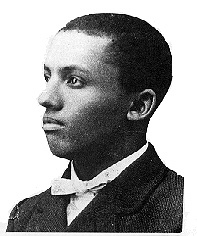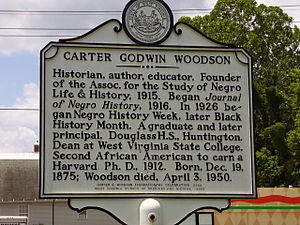
Carter G. Woodson

|
Carter G. Woodson was born December 19, 1875, the son of former enslaved Africans, James and Eliza Riddle Woodson. His father helped Union soldiers during the Civil War, and he moved his family to West Virginia when he heard that Huntington was building a high school for blacks. Coming from a large, poor family, Carter Woodson could not regularly attend school. Through self-instruction, Woodson mastered the fundamentals of common school subjects by age 17.
Wanting more education, Carter went to Fayette County to earn a living as a miner in the coal fields. He was able to devote only a few months each year to his schooling. In 1895, at age 20, Woodson entered Douglass High School, where he received his diploma in less than two years. From 1897 to 1900, Woodson taught in Fayette County. In 1900 he was selected as the principal of Douglass High School. He earned his Bachelor of Literature degree from Berea College in Kentucky in 1903 by taking classes part-time between 1901 and 1903.
From 1903 to 1907, Woodson was a school supervisor in the Philippines. Later, he attended the University of Chicago, where he was awarded an A.B. and A.M. in 1908. He was a member of the first black fraternity Sigma Pi Phi and a member of Omega Psi Phi. He completed his Ph.D. in history at Harvard University in 1912, where he was the second African-American (after W.E.B. DuBois) to earn a doctorate. His doctoral dissertation, The Disruption of Virginia, was based on research he did at the Library of Congress while teaching high school in Washington, D.C. After earning the doctoral degree, he continued teaching in the public schools, later joining the faculty at Howard University as a professor, where he served as Dean of the College of Arts and Sciences.
Career
Convinced that the role of his own people in American history and in the history of other cultures was being ignored or misrepresented among scholars, Woodson realized the need for research into the neglected past of African Americans. Along with Alexander L. Jackson and three aswas the year Woodson published The Education of the Negro Prior to 1861. His other books followed: A Century of Negro Migratiinues to be published by the Association for the Study of African American Life and History (ASALH).
His final professional appointment in West Virginia was as the Dean of the West Virginia Collegiate Institute, now West Virginia State University, from 1920–22.
He studied many aspects of African-American history. For instance, in 1924, he published the first survey of free white slave owners.
NAACP
Woodson became affiliated with the Washington, D.C. branch of the NAACP, and its chairman Archibald Grimké. On January 28, 1915, he wrote a letter to Grimké expressing his dissatisfaction with activities. Woodson made two proposals:
W. E. B. Du Bois added the proposal to divert "patronage from business establishments which do not treat races alike," that is, boycott businesses. Woodson wrote that he would cooperate as one of the twenty-five effective canvassers, adding that he would pay the office rent for one month. Grimke did not welcome Woodson's ideas.
Responding to Grimke's comments about his proposals, on March 18, 1915, Woodson wrote,
"I am not afraid of being sued by white businessmen. In fact, I should welcome such a law suit. It would do the cause much good. Let us banish fear. We have been in this mental state for three centuries. I am a radical. I am ready to act, if I can find brave men to help me."
His difference of opinion with Grimké, who wanted a more conservative course, contributed to Woodson's ending his affiliation with the NAACP.

Roadside historical marker biography of Woodson
Black History Month
After leaving Howard University because of differences with its president, Dr. Woodson devoted the rest of his life to historical research. He worked to preserve the history of African Americans and accumulated a collection of thousands of artifacts and publications. He noted that African American contributions "were overlooked, ignored, and even suppressed by the writers of history textbooks and the teachers who use them." Race prejudice, he concluded, "is merely the logical result of tradition, the inevitable outcome of thorough instruction to the effect that the Negro has never contributed anything to the progress of mankind."
In 1926, Woodson pioneered the celebration of "Negro History Week", designated for the second week in February, to coincide with marking the birthdays of Abraham Lincoln and Frederick Douglass. The week of recognition became accepted and has been extended as the full month of February, now known as Black History Month.
Colleagues
Woodson believed in self-reliance and racial respect, values he shared with Marcus Garvey, a Jamaican activist who worked in New York. Woodson became a regular columnist for Garvey's weekly Negro World.
Woodson's political activism placed him at the center of a circle of many black intellectuals and activists from the 1920s to the 1940s. He corresponded with W. E. B. Du Bois, John E. Bruce, Arturo Alfonso Schomburg, Hubert H. Harrison, and T. Thomas Fortune among others. Even with the extended duties of the Association, Woodson made time to write academic works such as The History of the Negro Church (1922), The Mis-Education of the Negro (1933), and others which continue to have wide readership.
Woodson did not shy away from controversial subjects, and used the pages of Black World to contribute to debates. One issue related to West Indian/African American relations. Woodson summarized that "the West Indian Negro is free." He observed that West Indian societies had been more successful at properly dedicating the necessary amounts of time and resources needed to educate and genuinely emancipate people. Woodson approved of efforts by West Indians to include materials related to Black history and culture into their school curricula.
Woodson was ostracized by some of his contemporaries because of his insistence on defining a category of history related to ethnic culture and race. At the time, these educators felt that it was wrong to teach or understand African-American history as separate from more general American history. According to these educators, "Negroes" were simply Americans, darker skinned, but with no history apart from that of any other. Thus Woodson's efforts to get Black culture and history into the curricula of institutions, even historically Black colleges, were often unsuccessful. Today African-American studies have become specialized fields of study in history, music, culture, literature and other areas; in addition, there is more emphasis on African-American contributions to general American culture. The United States celebrates Black History Month.
Woodson's legacy
That schools have set aside a time each year, to focus upon African American history, is Dr. Woodson's most visible legacy. His determination to further the recognition of the Negro in American and world history, however, inspired countless other scholars. Woodson remained focused on his work throughout his life. Many see him as a man of vision and understanding. Although Dr. Woodson was among the ranks of the educated few, he did not feel particularly sentimental about elite educational institutions. The Association and journal which he started in 1915 continue, and both have earned intellectual respect.
Woodson's other far-reaching activities included the founding in 1920 of the Associated Publishers, the oldest African-American publishing company in the United States. This enabled publication of books concerning blacks which may not have been supported in the rest of the market. He founded Negro History Week in 1926 (now known as Black History Month). He created the Negro History Bulletin, developed for teachers in elementary and high school grades, and published continuously since 1937. Woodson also influenced the Association's direction and subsidizing of research in African-American history. He wrote numerous articles, monographs and books on Blacks. The Negro in Our History reached its eleventh edition in 1966, when it had sold more than 90,000 copies.
Dorothy Porter Wesley stated that "Woodson would wrap up his publications, take them to the post office and have dinner at the YMCA." He would teasingly decline her dinner invitations saying, "No, you are trying to marry me off. I am married to my work". Dr. Woodson's most cherished ambition, a six-volume Encyclopedia Africana, lay incomplete at his death on April 3, 1950 at the age of 74. He is buried at Lincoln Memorial Cemetery in Suitland, Maryland.
(Note this article was sent in by Ed Prichard)
[ BACK ]